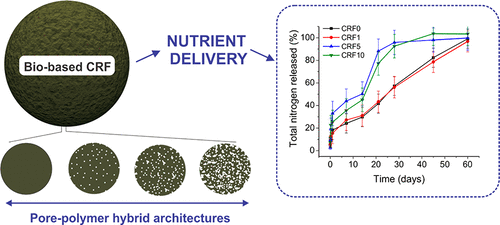当前位置:
X-MOL 学术
›
ACS Sustain. Chem. Eng.
›
论文详情
Our official English website, www.x-mol.net, welcomes your
feedback! (Note: you will need to create a separate account there.)
Use of Biogenic Silica in Porous Alginate Matrices for Sustainable Fertilization with Tailored Nutrient Delivery
ACS Sustainable Chemistry & Engineering ( IF 7.1 ) Pub Date : 2018-01-16 00:00:00 , DOI: 10.1021/acssuschemeng.7b04331 Mailson de Matos 1 , Bruno D. Mattos 1, 2 , Blaise L. Tardy 2 , Orlando J. Rojas 2, 3 , Washington L. E. Magalhães 1, 4
ACS Sustainable Chemistry & Engineering ( IF 7.1 ) Pub Date : 2018-01-16 00:00:00 , DOI: 10.1021/acssuschemeng.7b04331 Mailson de Matos 1 , Bruno D. Mattos 1, 2 , Blaise L. Tardy 2 , Orlando J. Rojas 2, 3 , Washington L. E. Magalhães 1, 4
Affiliation

|
Population growth coupled with significant pressure for clean agricultural practices puts a heavy burden on conventional crop treatments that target high yields with minimal cropland expansion. Optimization of fertilization systems is required as part of the solutions to current megatrends. Herein, we present a sustainable strategy to achieve controlled release formulations for nitrogen fertilization. Specifically, we used interfacial engineering to design alginate-based matrices that incorporated biogenic silica particles to achieve increased interfacial area for dynamic entrapment and release of ammonium nitrate. The incorporation of biogenic silica in the alginate matrix provided a porous architecture spanning length scales from the micro- (within particles) to the macrosize (within the polymeric matrix) levels, leading to tunable patterns of nitrogen release. Alginate–biogenic silica granules approached the European requirements of “slow-release” compositions. At optimized silica content, 15% of the nitrogen was released within 24 h and 56% over 28 days. The complete nitrogen dissolution was achieved after 60 days. The experimental results and kinetic models provided insights on the mechanisms driving the nitrogen release from the alginate–silica matrix as a function of the pore–polymer hybrid architectures.
中文翻译:

在多孔藻酸盐基质中使用生物硅来持续定制施肥,并提供量身定制的养分
人口增长加上清洁农业实践的巨大压力,给以高产量和最少农田扩张为目标的常规作物处理带来了沉重负担。作为当前大趋势解决方案的一部分,需要优化施肥系统。在这里,我们提出了一种可持续的策略来实现控释氮肥配方。具体而言,我们使用界面工程技术设计了基于藻酸盐的基质,该基质结合了生物二氧化硅颗粒,以实现增加的界面面积,从而实现动态截留和释放硝酸铵。在藻酸盐基质中掺入生物硅提供了一种多孔结构,其长度范围从微米(颗粒内)到宏观(聚合物基体内)不等,导致可调节的氮释放模式。海藻酸盐-生物硅石颗粒达到了欧洲对“缓释”组合物的要求。在优化的二氧化硅含量下,氮气在24小时内释放了15%,在28天内释放了56%。60天后氮完全溶解。实验结果和动力学模型为驱动藻酸盐-二氧化硅基质中氮释放的机理提供了见解,而这些机理是孔隙-聚合物杂化结构的函数。
更新日期:2018-01-16
中文翻译:

在多孔藻酸盐基质中使用生物硅来持续定制施肥,并提供量身定制的养分
人口增长加上清洁农业实践的巨大压力,给以高产量和最少农田扩张为目标的常规作物处理带来了沉重负担。作为当前大趋势解决方案的一部分,需要优化施肥系统。在这里,我们提出了一种可持续的策略来实现控释氮肥配方。具体而言,我们使用界面工程技术设计了基于藻酸盐的基质,该基质结合了生物二氧化硅颗粒,以实现增加的界面面积,从而实现动态截留和释放硝酸铵。在藻酸盐基质中掺入生物硅提供了一种多孔结构,其长度范围从微米(颗粒内)到宏观(聚合物基体内)不等,导致可调节的氮释放模式。海藻酸盐-生物硅石颗粒达到了欧洲对“缓释”组合物的要求。在优化的二氧化硅含量下,氮气在24小时内释放了15%,在28天内释放了56%。60天后氮完全溶解。实验结果和动力学模型为驱动藻酸盐-二氧化硅基质中氮释放的机理提供了见解,而这些机理是孔隙-聚合物杂化结构的函数。











































 京公网安备 11010802027423号
京公网安备 11010802027423号